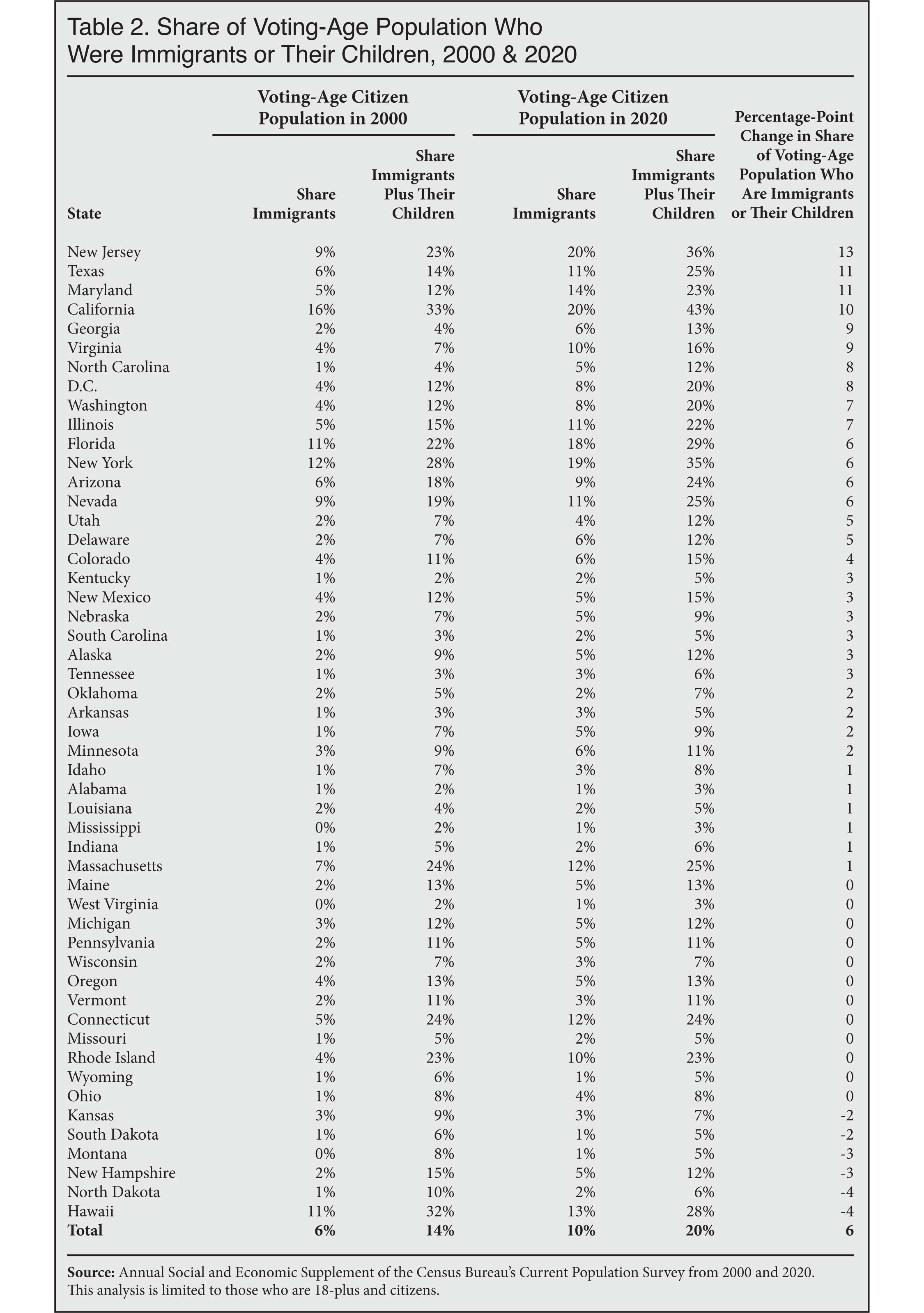Analysis of Census Bureau data shows that the population of adult immigrants and their adult U.S.-born children has grown dramatically, but unevenly, across the country since 2000 as a share of eligible voters. New Jersey, Texas, Maryland, California, Georgia, Virginia, and North Carolina in particular have experienced dramatic increases in the share of eligible voters who are immigrants or their children.
Eligible voters are all citizens (naturalized or U.S.-born) 18 years of age or older. This analysis looks at the share of eligible voters who are naturalized citizens or U.S.-born adults with at least one immigrant parent. It is based on the Annual Social and Economic Supplement of the Census Bureau's Current Population Survey from 2000 and 2020, which is collected in March each year. The survey asks respondents about their citizenship and their parents' place of birth.
Key findings (see Tables 1 and 2 for complete results):
- As a share of eligible voters, between 2000 and 2020 adult immigrants and their adult U.S.-born children increased the most in New Jersey, from 23 percent to 36 percent; Texas, from 14 percent to 25 percent; Maryland, from 12 percent to 23 percent; California, from 33 percent to 43 percent; Georgia, from 4 percent to 13 percent; Virginia, from 7 percent to 16 percent; and in North Carolina, from 4 percent to 12 percent.
- Proportionally, immigration has had the most transformational impact on the electorate in states of the South. The share of potential voters who are immigrants or their children increased more than three-fold in North Carolina and Georgia. It doubled in Virginia and Kentucky, and it nearly doubled in South Carolina and Maryland.
- The growth in numbers between 2000 and 2020 in North Carolina and Georgia is by far the most striking. In North Carolina, the number of eligible voters who are immigrants or their children increased by 355 percent — while the rest of the potential electorate grew by just 22 percent. In Georgia, the number increased by 337 percent — while the rest of the potential electorate grew by only 17 percent.
- Nationally, the number of voting-age citizens who are immigrants or their children increased by 71 percent, while the rest of the potential electorate grew by just 15 percent between 2000 and 2020. As a share of eligible voters, immigrants and their children increased their share from 14 percent to 20 percent.
- While the general trend has been for the number of immigrants and their children to increase rapidly, this has not been the case everywhere. In New Hampshire, Kansas, South Dakota, Montana, and North Dakota the number of voting-age citizens who are immigrants or their children fell between 2000 and 2020.
- Reflecting the uneven growth throughout the country, there remain 12 states where immigrants and their children are less than 6 percent of potential voters.
- Nationally, in 2020 about half (48 percent) of the voting-age people of what the Census Bureau used to call "foreign stock" are immigrants and the rest are U.S.-born children with at least one immigrant parent. All of those we identify as naturalized U.S. citizens are assumed to be legally present in the United States. However, some share of naturalized citizens are former illegal immigrants who were awarded citizenship in 1986 as part of the IRCA amnesty or subsequent amnesties. Others are former illegal immigrants who received green cards over the years as part of the "normal" legal immigration process.
States Where the Voting-Age Population of Immigrants or their Children Grew the Most, 2000 to 2020 |
 |
|
Source: Center for Immigration Studies analysis of the 2000 and 2020 Annual Social and Economic Supplement of the Current Population Survey. |
 |
 |
